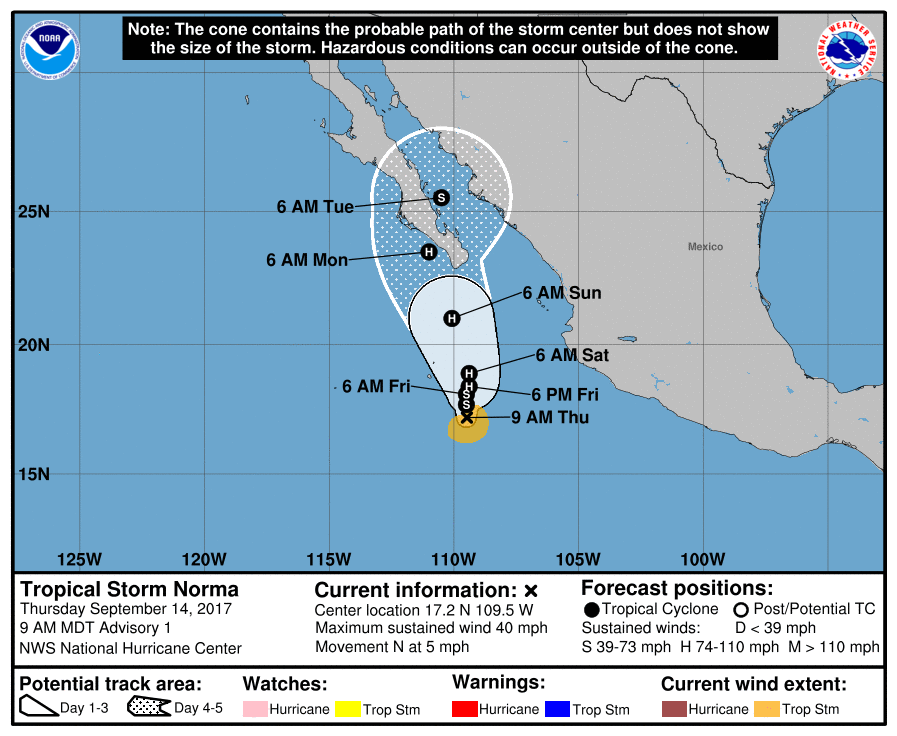簽到天數: 4744 天 [LV.Master]伴壇終老
|
 s6815711|2017-9-15 00:02
|
顯示全部樓層
s6815711|2017-9-15 00:02
|
顯示全部樓層
補個報文
ZCZC MIATCDEP2 ALL
TTAA00 KNHC DDHHMM
Tropical Storm Norma Discussion Number 1
NWS National Hurricane Center Miami FL EP172017
900 AM MDT Thu Sep 14 2017
The convective structure of the area of disturbed weather well to
the south of the Baja California peninsula has continued to
increase in organization, with an elongated band wrapping around
the southern and eastern sides of the circulation. Dvorak intensity
estimates have increased to T3.0/45 kt from TAFB and T2.0/30 kt
from SAB, so the system is now classified as a 35-kt tropical storm.
Since Norma has just recently consolidated, its motion is a little
uncertain, but the best estimate is slowly northward, or 360/4 kt.
Norma is located to the northwest of a mid-level ridge that extends
westward from Central America, but it is also due south of a
blocking high centered over northwestern Mexico. As a result, the
storm is expected to only drift slowly northward for the next 48
hours or so. After 48 hours, a more pronounced northward motion is
forecast, but there is a lot of spread among the track models
regarding exactly how fast Norma moves north and if it moves east or
west at all. On the eastern side of the guidance envelope, the GFS
has a weaker ridge over Mexico and a deeper trough off the
California coast, which would cause Norma to turn northeastward
near the southern part of the Baja California peninsula. On the
western side of the guidance, the ECMWF maintains a stronger ridge,
forcing Norma to turn northwestward to the west of the Baja
California peninsula. Until the evolving pattern becomes clearer,
the NHC track forecast is between these two extremes and lies
closest to the HFIP Corrected Consensus Approach (HCCA).
Norma is over very warm waters and should remain in a low-shear
environment for at least the next 48-72 hours. As a result,
steady strengthening is anticipated, and Norma could reach
hurricane strength within about 36 hours. Strengthening should
continue through 48-72 hours until vertical shear begins to
increase, and a weakening trend is likely to occur on days 4 and 5.
The NHC intensity forecast closely follows the SHIPS guidance and
the ICON intensity consensus, and it is slightly below the HCCA
output.
FORECAST POSITIONS AND MAX WINDS
INIT 14/1500Z 17.2N 109.5W 35 KT 40 MPH
12H 15/0000Z 17.7N 109.5W 45 KT 50 MPH
24H 15/1200Z 18.1N 109.5W 55 KT 65 MPH
36H 16/0000Z 18.4N 109.4W 65 KT 75 MPH
48H 16/1200Z 18.9N 109.4W 75 KT 85 MPH
72H 17/1200Z 21.0N 110.1W 75 KT 85 MPH
96H 18/1200Z 23.5N 111.0W 65 KT 75 MPH
120H 19/1200Z 25.5N 110.5W 55 KT 65 MPH
$$
Forecaster Berg
NNNN 
|
|